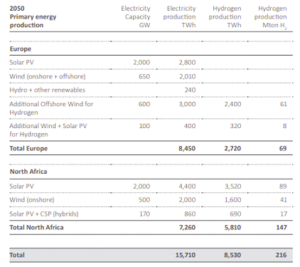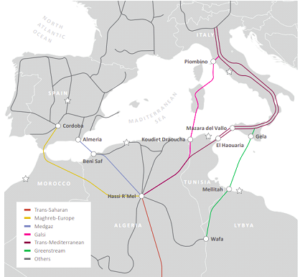Written by : Dr.Sakreddine Manai, Hydrogen Technology Specialist
Translated by : The cannabist
A common strategy between Europe and North Africa can help build an energy system based on 50% of renewable electrical energy and 50% of green hydrogen by 2050.
The hydrogen produced in North Africa would be benefit to Europe along with North Africa.
For Europe, green hydrogen is produced in Europe and completed by importation, mainly from North Africa. A Bold strategy from the energy sector with an infrastructural component should be considered. This approach assures an optimized use of of existing infrastructures, has low risks and costs, improves the european energetic security and supports its technological leadership. In North Africa, it would favor economical development, stimulate exports, create jobs of the future in highly technological sector and would support social stability.
A european energetic system based on 50% green electricity and 50% green hydrogen, developed by a mutual cooperation with North Africa to the profit of both parties, would have enormous advantages:
- the energetic system would be entirely green, without CO2 emissions, which complies with the Paris accord. It would also have a massive advantages for health with the local emissions reduced in european and african cities.
- The system would be separate from other systems based on limited resources, which always ends in shortage and expensive costs. The green hydrogen system would be 100% based on rewable energy and technologies getting cheaper with time.
- A level of european ambition based on technologies approved but largely under-developped (e.g. electrolysers, gasifiers, fuel cells, hydrogen storage technologies, new household appliances, hydrogen-electric mobility, chemicals and synthetic green fuels) offers a great opportunity for worldwide technological leadership with economical dynamics along with expansions in the job market.
- The necessary infrastructure at the systemic level will be largely based on the existing natural gas networks and avoids an expensive revision and a massive expansion of the electrical grid/network.
- The energetic system would be reliable with a balanced offer and demand at all times and space (countries implementing the said system) thanks to large scale cheap storage of hydrogen, particularly in salt caves as well as hybrid public electrical-hydrogen infrastructures.
- The develoment of a clean energetic system with a North African-European partnership opens the acces to vast cheap renewable energy resources for both parties while supporting the develpment of a affordable energy, reliable and clean for North Africa.
- Both North Africa and Europe can take advantage of this cooperation which creates an important economical development, new enterprises, exports, jobsd and well being.
The develoment of a clean energetic system in North Africa for its own usage and exports, creates jobs and better life conditions, thus reducing the necessity for imigration to Europe.
Table 1 : Primary energy production in Europe and in North Africa for its use in the UE in 2050[1]

The following elements are necessary for the elaboration of an effecient schedule :
- A strong and sustainable political engagement anchored in a constraining strategy with clear objectives stretching over decades.
- A new type of private-public partnership at the paneuropean level
- A new regulated favorable environment and the conception of the associated market are mandatory for the required investments while maintaining the system’s costs at an affordable level.
- the conception of an integrated political framework for the electrical-hydrogen structure and storage systems (i.e. infrastructure) with fair access to energy for all.
- Most of all the design and implementation of a new mutual cooperation, social, economical and politically unique and sustainable, between the UE and North Africa. This cooperation must be based in mutual respect and trust, while considering cultural, social and economical features of each party.

Figure 1. UE and North Africa can both profit from this cooperation, which creates economical development, new enterprises, exports, jobs and well being in both NA and the UE. The development of a clean enegetic system in NA, for its own usage and export, creates an infrastructure of natural gas between UE and NA is a first draft for an infrastructure specialized in hydrogen. The existing gas infrastructure in Algeria and Marroco can be converted to an infrastructure for hydrogen (grey and orange lines on the map). A new gas pipeline must be built between Italy and Greece, crossing the mediterranean sea to Egypt, which would eventually be extended to the middle east.[1]
[1] Prof. Dr. Ad van Wijk 2019 A North Africa – Europe Hydrogen Manifesto
[2] Lanphen, S. (2019). Hydrogen Import Terminal; Providing insights in the cost of supply chain of various hydrogen carriers for the import of hydrogen. MsC thesis, TU Delft, Delft. Michalski, J.,
[3] Bünger, U., Crotogino, F., Donadei, S., Schneider, G., Pregger, T., & al, e. (2017). Hydrogen generation by electrolysis and storage in salt caverns: Potentials, economics and systems aspects with regard to the German energy transition. International Journal of Hydrogen.


